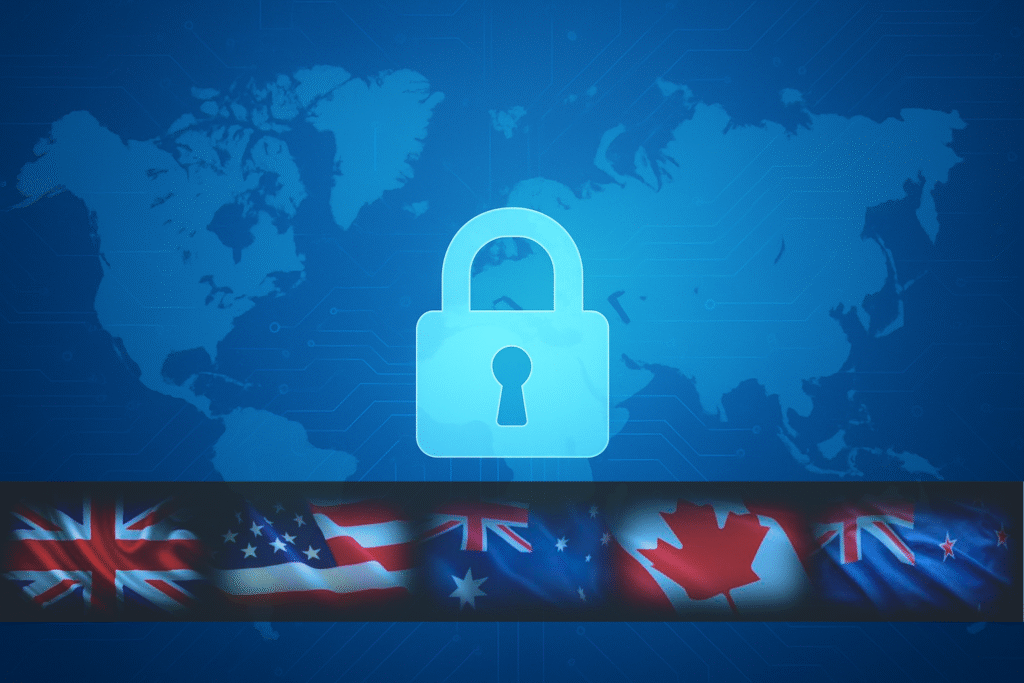
In a world defined by rising cyber aggression and intensifying geopolitical rivalries, the Five Eyes alliance stands as a pillar of shared defense and democratic values. Born from the hard lessons of global conflict, this decades-old partnership has evolved into the backbone of international intelligence collaboration, enabling its members to detect, deter, and disrupt a broad spectrum of threats. Yet the resilience of this alliance is not guaranteed. Political upheavals, changing national priorities, and a surge of hybrid attacks are putting unprecedented pressure on its foundations.
As new presidential cycles bring old debates roaring back, the question of how to safeguard the Five Eyes alliance against internal disruption has taken on renewed urgency. Can five democracies with differing interests sustain the trust and cohesion needed to counter powerful adversaries? And what happens when the political leadership of its largest member throws that trust into doubt?
These questions strike at the heart of Western security in a rapidly shifting cyber domain. Understanding how the Five Eyes alliance arrived at this moment, and what might threaten its future, is essential for anyone who cares about defending democratic systems against the next wave of state-backed cyber aggression.
As you read, consider signing up for the Quantum Cyber AI Brief to stay ahead of these critical developments. AI is rewriting the rules of cyber conflict. Our briefings cover what regulators miss, from state-backed hacking to digital identity rollbacks. Stay ahead of policy, strategy, and global risks by subscribing now.
Introduction to the Five Eyes Alliance
Historical Roots of the Five Eyes

The Five Eyes alliance emerged from the ashes of World War II, when intelligence cooperation became essential to counter new global threats. Originally formalized through the UKUSA Agreement in 1946, the network linked British and American codebreaking efforts with the broader postwar signals intelligence mission. Canada, Australia, and New Zealand soon joined, creating a five-nation structure that could share intercepted communications and signals data seamlessly. During the Cold War, the Five Eyes alliance expanded its surveillance capabilities to monitor Soviet military moves and other adversarial activities, providing a backbone of strategic defense for the Western bloc.
This historic structure laid the groundwork for today’s global cybersecurity cooperation. It showed that sharing intelligence across borders was not only possible but highly effective in protecting democratic societies. The values of transparency, accountability, and democratic oversight also shaped the alliance’s operations, helping to legitimize its role in counterintelligence and allied cyber defense.
Structure and Membership Today
Currently, the Five Eyes alliance includes five members: the United States, the United Kingdom, Canada, Australia, and New Zealand. Each member brings its own unique intelligence infrastructure and regional strengths. The United States, through the NSA, contributes advanced signals analysis and global surveillance capabilities. The United Kingdom’s GCHQ offers deep cyber expertise and technical skills. Canada, Australia, and New Zealand add complementary resources, extending the alliance’s geographic and political reach.
These countries exchange intelligence on a near-daily basis through classified networks and secure communications systems. Protocols are standardized to ensure that high-grade intelligence flows quickly and securely among partners. That operational cohesion is what has allowed the Five Eyes alliance to move fast against global threats, supporting counterterrorism, foreign policy objectives, and resilience against cyber threats. The alliance is respected globally as a benchmark for international intelligence sharing.
Scope of Shared Missions
The Five Eyes alliance supports an extraordinary range of shared missions that stretch beyond military data. Joint counterterrorism efforts, for instance, have helped foil extremist plots targeting Western cities. Coordinated cyber defense operations safeguard critical infrastructure, including power grids, hospitals, and supply chains. International intelligence sharing through Five Eyes channels has also helped expose disinformation campaigns, ransomware attacks, and influence operations by nation-state actors.
These missions underscore why the Five Eyes alliance is critical to allied cyber defense today. As global tensions rise and Trump foreign policy discussions loom ahead of the next election, many policymakers fear that the entire architecture of the alliance could be put under strain. The Five Eyes’ ability to support cybersecurity cooperation is only as strong as its internal trust, which is why any potential political disruptions carry such high stakes.
This sets the stage for examining how Trump’s first term tested the boundaries of Five Eyes unity and revealed vulnerabilities in its future resilience.
Trump’s First Term and Alliance Strains
Huawei and the UK 5G Dispute
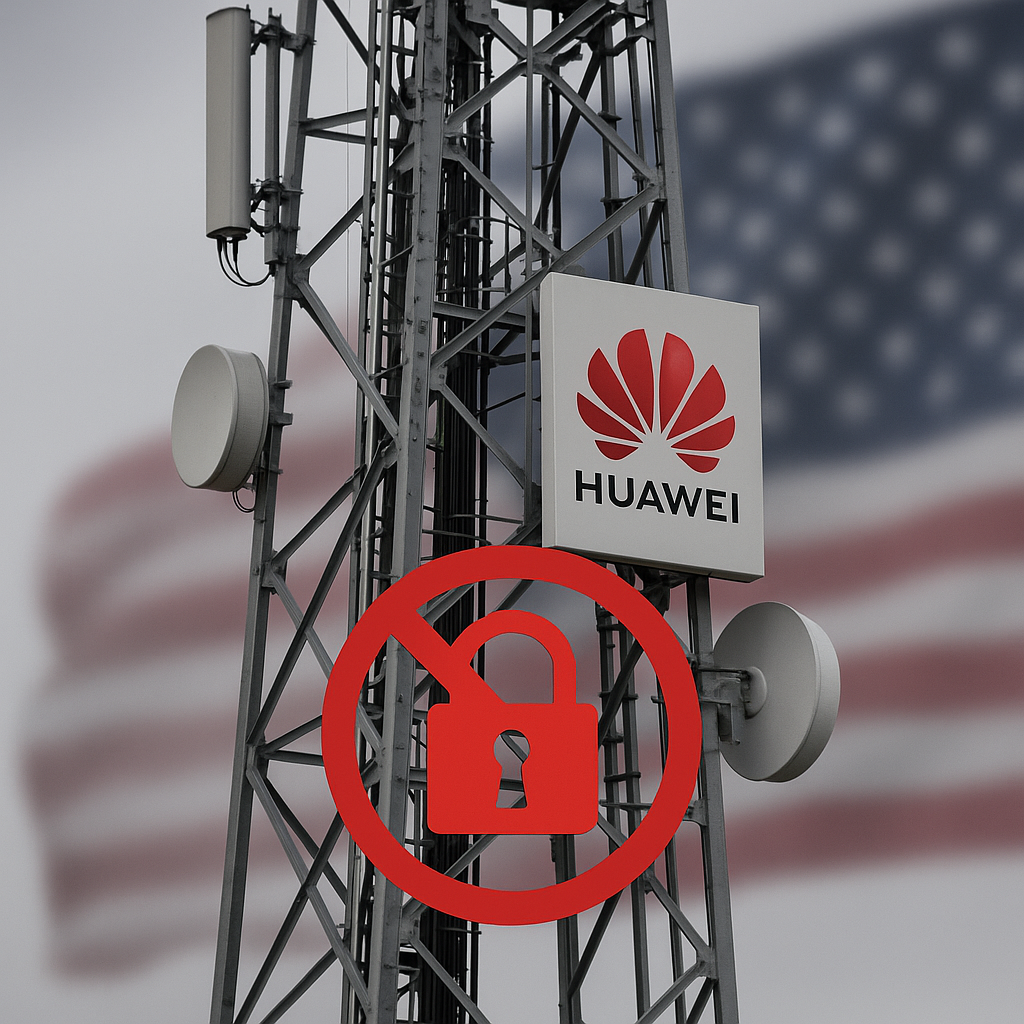
During Donald Trump’s first term, one of the most visible threats to the stability of the Five Eyes alliance came through the Huawei 5G controversy. In 2020, the United Kingdom announced it would allow Huawei limited access to build out portions of its 5G telecommunications network. The Trump administration reacted with fierce opposition, threatening to suspend intelligence sharing with the UK if Huawei remained involved. The U.S. claimed Huawei’s ties to the Chinese government posed an unacceptable cybersecurity risk that could undermine the security of allied cyber defense systems.
This dispute placed enormous pressure on the UK, forcing it to weigh the benefits of 5G modernization against the survival of its trusted relationship inside the Five Eyes alliance. In the end, the UK pivoted toward stricter restrictions on Huawei equipment, seeking to calm U.S. fears. However, the incident highlighted how a sudden Trump foreign policy move could destabilize intelligence cooperation among long-standing allies. It also signaled to other Five Eyes members that their own domestic technology decisions might come under similar scrutiny, challenging their sovereignty over critical infrastructure.
Multilateral Fallout from Iran Deal Withdrawal
Another defining moment of Trump’s first term was the 2018 withdrawal from the Joint Comprehensive Plan of Action, better known as the Iran nuclear deal. By pulling out of this agreement, the Trump administration strained multilateral security efforts designed to monitor and limit Iran’s nuclear capabilities. Five Eyes partners, including the UK and Canada, had strongly supported the deal as a way to stabilize the region and prevent nuclear proliferation.
Trump’s exit from the agreement created new tensions among Five Eyes members, especially around intelligence priorities. Suddenly, joint resources had to pivot to assessing Iranian retaliatory threats, creating friction between members who wanted to maintain cooperative diplomatic channels and those aligning more closely with Washington’s maximum-pressure stance. These policy contradictions disrupted routine international intelligence sharing and revealed how vulnerable the Five Eyes alliance could become under unpredictable leadership shifts.
Trust Erosion Among Partners
Beyond specific policy conflicts, Trump’s first term also triggered a deeper trust erosion inside the Five Eyes alliance. Political unpredictability, personal attacks on U.S. intelligence leaders, and sudden shifts in foreign policy made other alliance members question whether Washington could be counted on to honor traditional cooperative norms. After Trump revealed highly classified intelligence to Russian officials in 2017, experts and former officials warned that Five Eyes partners could scale back cooperation to protect their own sources and methods, fearing further leaks. Analysts described this as a worst-case scenario for U.S. allies and a grave threat to shared security.
When partners hesitate to share vital data, the entire structure of cybersecurity cooperation is at risk. A breakdown in trust means critical warning signals may arrive too late, or not at all, leaving allies exposed. For the Five Eyes alliance, trust is the backbone of operational readiness. If Trump foreign policy choices continue to prioritize unilateral moves over collaborative intelligence frameworks, allied cyber defense efforts could be dangerously undermined.
This record of strained partnerships during Trump’s first term sets up a crucial question. Could another four years of the same approach further fracture one of the world’s strongest intelligence-sharing alliances? The next section will dig into how these risks play out in the cyber domain and what that means for future resilience.
Cybersecurity Risks for Allied Networks
Lessons from SolarWinds and Similar Attacks
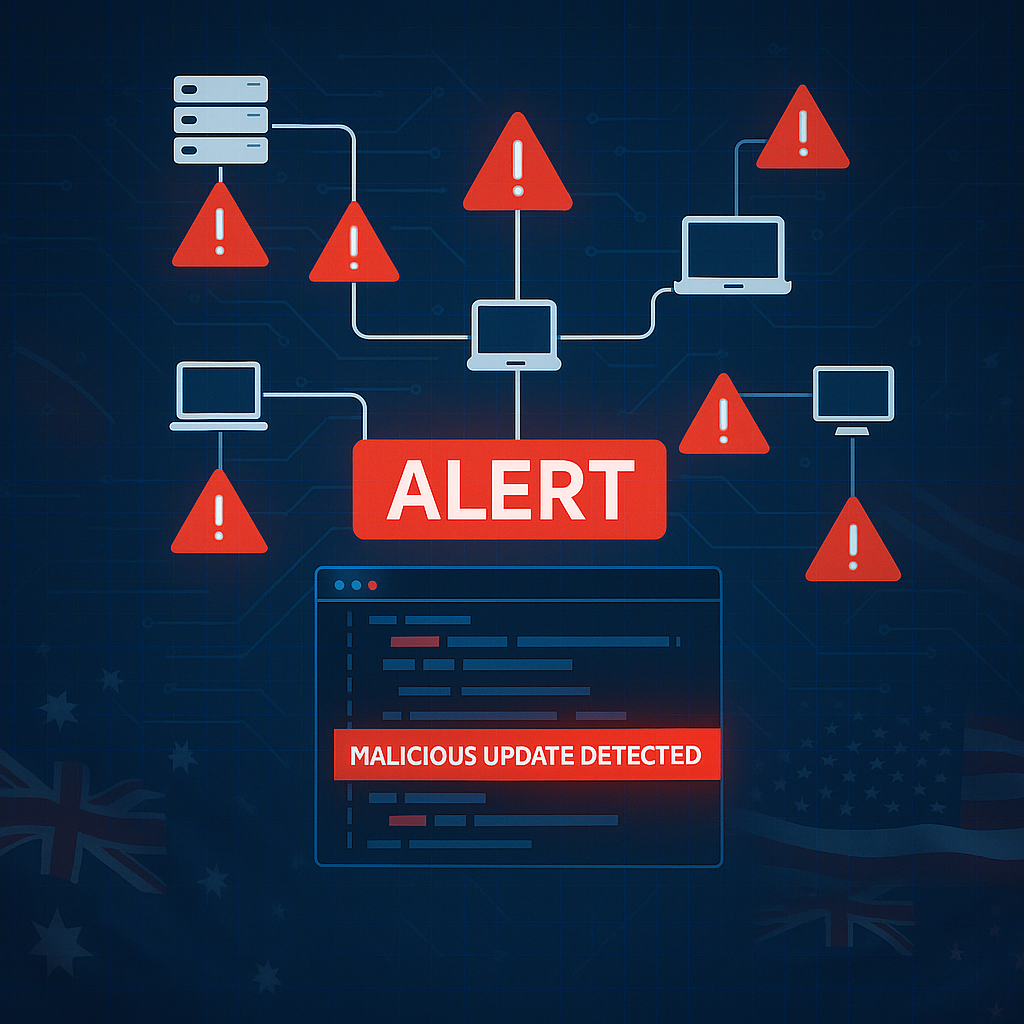
The 2020 SolarWinds attack revealed the staggering scale of modern supply chain intrusions and highlighted the interconnectedness of Five Eyes alliance networks. By compromising a widely used IT management platform, Russian-backed attackers gained access to sensitive data inside multiple U.S. government agencies and private firms. Because Five Eyes members often share systems and security protocols, such intrusions can quickly cascade beyond one nation’s borders.
The SolarWinds hack forced the Five Eyes alliance to rethink its collective cyber posture. Intelligence partners had to coordinate fast to identify infected nodes, block malware propagation, and share forensic findings. The lessons were stark. Weakness in any member’s infrastructure exposes every other partner. The episode showed that no country, even with advanced cybersecurity cooperation, can stand alone against a determined nation-state actor.
Cybersecurity cooperation among Five Eyes members is essential to manage these multi-vector attacks. During the SolarWinds response, analysts saw how detection delays could ripple across shared systems. The incident reinforced the urgency of continuously improving cyber threat hunting, patch management, and rapid information sharing across the alliance to keep allied cyber defense resilient.
Risks from Fragmented U.S. Cyber Leadership
If a second Trump foreign policy term repeats the unpredictability of the first, the Five Eyes alliance could see serious gaps in U.S. cyber leadership. Political churn and shifting priorities can damage stable funding for cybersecurity programs, delay upgrades for critical systems, and slow joint exercises vital for real-time coordination. Allies worry that a fractured U.S. approach could leave them vulnerable when they need rapid support from the alliance’s largest member.
Cybersecurity cooperation relies on consistent leadership and clear priorities. Without them, nation-state attackers could exploit timing gaps and exploit weaknesses in global defense structures. A disjointed U.S. strategy would make it harder for the Five Eyes alliance to organize collective cyber responses, monitor adversary tactics, and safeguard critical networks. In the wake of SolarWinds, these concerns cannot be dismissed.
Growing Threats from China and Russia
Beyond technical weaknesses, geopolitical rivals like China and Russia are constantly testing the Five Eyes alliance. These countries see opportunities to disrupt allied cyber defense through espionage, ransomware, and data manipulation campaigns A concrete example is China’s Volt Typhoon APT, known to infiltrate U.S. critical infrastructure through credential theft and “living‑off‑the‑land” tactics, highlighting how adversaries probe alliance seams during policy shifts As U.S. cyber policy swings with political changes, adversaries may feel emboldened to strike while coordination is weakest.
China, for example, has accelerated influence operations targeting political discourse and critical infrastructure in Western democracies. Russia continues to develop complex hybrid attacks that blend hacking with disinformation, undermining public trust and sowing discord. These hostile actions put the Five Eyes alliance under severe pressure to maintain unified, adaptive defenses.
A relevant perspective comes from our own feature, AI Cybersecurity Arms Race: 7 Alarming Signs Hackers Are Winning, which shows how advanced technologies in the hands of state-backed groups can accelerate these risks. If the Five Eyes alliance cannot maintain political unity, China and Russia will likely continue to probe for weaknesses, taking advantage of any slow or uncoordinated response.
As these challenges mount, the Five Eyes alliance must stay proactive, nimble, and fully committed to intelligence sharing to avoid a repeat of SolarWinds or worse. Against this backdrop, it is important to explore how political pressures can distort intelligence flows within the alliance and threaten operational trust.
Intelligence Sharing Under Political Pressure
Politicization of Intelligence
One of the gravest risks to the Five Eyes alliance during the Trump foreign policy era was the politicization of intelligence. In January 2019, then Director of National Intelligence Dan Coats publicly contradicted President Trump’s claims during the Senate Select Committee’s Worldwide Threats hearing, disputing the administration’s positions on North Korea, Russia, ISIS, and Iran. Coats emphasized the importance of speaking “truth to power,” warning that undermining objective assessments could embolden adversaries and erode allied trust
The Five Eyes alliance depends on a foundation of objective, evidence-based analysis to protect against global threats. If data is filtered or selectively presented to fit short-term political aims, partners will start doubting its reliability. That doubt breaks down the very cybersecurity cooperation needed to protect national security infrastructure across allied networks. Allies cannot afford to wonder whether an intelligence briefing is accurate or politically manipulated in the heat of a crisis.
This challenge is compounded by domestic political swings that may prioritize short-term national interests over long-standing commitments to allied cyber defense. A second Trump foreign policy shift that repeats these patterns would place enormous strain on the trust that allows Five Eyes members to coordinate quickly and effectively. The stakes are high, since any hesitation in sharing critical alerts or forensic findings can provide an open window for attackers to exploit.
A valuable internal perspective is explored in NSA and Cyber Command: 5 Devastating Risks of a Split , which looks at how leadership fragmentation inside U.S. cyber structures could further complicate alliance trust. Political turmoil risks undermining even the best technology if partners cannot rely on unfiltered, timely, and truthful intelligence.
Trust Gaps and Information Integrity
Another danger is the erosion of information integrity. If international intelligence sharing becomes subject to wild swings in political mood, allies will increasingly hedge their bets by limiting what they reveal. That creates dangerous blind spots. A piece of cyber threat intelligence that arrives too late or with incomplete context can cripple a joint response. Trust gaps do not just weaken relationships, they expose entire allied systems to catastrophic risk.
Impact on Operational Readiness
Trust is the fuel that powers operational readiness across the Five Eyes alliance. Real-time decision-making, from blocking malware signatures to launching counter-espionage missions, relies on a seamless, trusted data flow. When intelligence is politicized, or members doubt the integrity of shared information, operational delays are inevitable.
If a future Trump foreign policy continues the unpredictable approach of the first term, the Five Eyes alliance could find itself hampered by second-guessing, hesitation, and duplication of efforts. That leaves windows of opportunity for adversaries to breach defenses and exploit critical vulnerabilities. Cybersecurity cooperation works only when all partners believe in the same facts and act on them in a timely manner.
This breakdown in readiness is not hypothetical. Recent testimony and open statements have made it clear that allies need consistent, values-driven leadership to maintain effective joint operations. Without it, international intelligence sharing and the entire foundation of allied cyber defense are at serious risk of fragmentation.
Now we will explore how other members of the Five Eyes alliance are responding and building resilience to offset these pressures.
Responses and Resilience Among Allies
Australia’s Cybersecurity Strategy and Investments
In the face of potential instability within the Five Eyes alliance, Australia has taken proactive steps to build its own cyber resilience. In 2020, the Australian government committed $1.35 billion to a comprehensive cybersecurity strategy designed to improve national defenses, harden networks, and strengthen public-private partnerships. This investment supports advanced cyber threat hunting, rapid response capabilities, and expanded skills training across critical infrastructure sectors.
Australia’s efforts serve as a hedge against the risk of reduced U.S. engagement or sudden changes in Trump foreign policy that could disrupt joint operations. By investing heavily in its own security posture, Australia is positioning itself to maintain operational continuity even if trust within the Five Eyes alliance is challenged. This approach helps ensure that allied cyber defense retains enough redundancy and agility to respond effectively to major threats.
UK’s National Cyber Security Centre Initiatives
The United Kingdom has also bolstered its cybersecurity framework through the National Cyber Security Centre (NCSC). The NCSC has expanded threat-hunting programs, improved information sharing pipelines, and strengthened support for private sector partners that maintain critical systems. These efforts are designed to keep the UK’s defensive capabilities strong, even if future U.S. policy changes create uncertainty for intelligence collaboration.
A major part of the NCSC’s mission is to build resilience not just for government systems but for the entire UK cyber ecosystem. That includes helping businesses and nonprofits identify vulnerabilities early and respond quickly to emerging threats. By focusing on cross-sector security, the UK is reinforcing the Five Eyes alliance through distributed capabilities that cannot be easily disrupted by political fluctuations in Washington or elsewhere.
Joint Cyber Exercises and Interoperability
To sustain a high level of allied cyber defense, Five Eyes members have dramatically increased the number and sophistication of joint exercises. For example, NATO’s Cyber Coalition 2023 involved advanced training scenarios that tested real-time cooperation among military, civilian, and private sector cybersecurity teams. These exercises help identify gaps in procedures, stress-test communications networks, and build personal relationships across agencies.
Routine exercises are critical to sustaining interoperability across the Five Eyes alliance. They ensure all partners can share data securely, patch systems quickly, and coordinate policy responses under pressure. These drills also build familiarity with shared tools and practices, which is essential in responding to high-speed attacks from adversaries like China or Russia. A strong cycle of joint training can offset some of the political volatility that comes with shifting Trump foreign policy priorities.
Through these investments, exercises, and expanded capabilities, the Five Eyes alliance is developing a more robust cushion against potential political instability. Building on this analysis, it is useful to consider how these strains might ripple out to NATO, the EU, and the wider global security order.
Broader Geopolitical Impacts
NATO’s Dependence on Five Eyes Intelligence
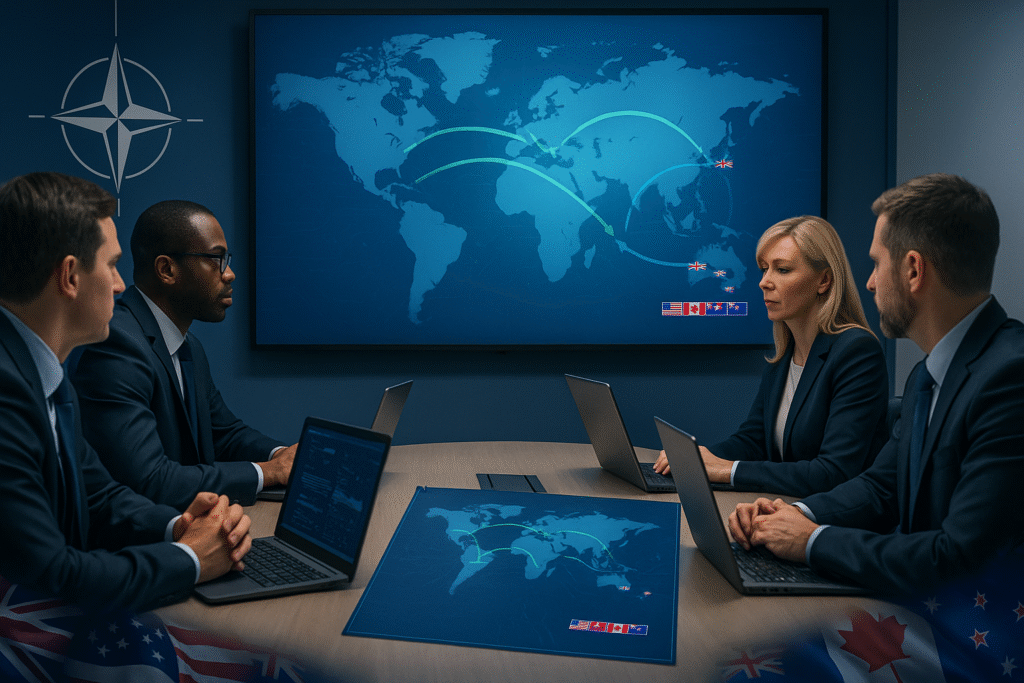
NATO has long benefited from the trusted intelligence streams provided by members who also participate in the Five Eyes alliance, specifically the United States, the United Kingdom, and Canada. In the 2022 Secretary General Annual Report, Jens Stoltenberg emphasized the role of coordinated intelligence in enabling rapid, informed decision-making across the alliance. This flow of data is critical for informing military deployments, cyber defense measures, and counter-disinformation campaigns.
If a second Trump foreign policy term disrupts the Five Eyes alliance, NATO could face greater risk. Intelligence blind spots would complicate its ability to defend Europe, coordinate with North American forces, and maintain a credible deterrent against adversaries such as Russia. Weakness in the Five Eyes could also undermine broader allied cyber defense, leaving NATO more exposed to advanced hybrid attacks that combine hacking with disinformation efforts.
Potential Opportunities for Adversaries
Geopolitical rivals such as Russia and China actively exploit fractures among Western alliances. Russia, in particular, has escalated hybrid warfare campaigns targeting NATO’s Eastern flank, deploying a mix of subversion, sabotage, cyber intrusions, and disinformation to undermine ally cohesion. If the Five Eyes alliance experiences further internal political strain, adversaries will find fertile ground to expand espionage, sow disinformation, and coordinate cyberattacks while allied trust remains fractured.
Russia’s hybrid warfare tactics, for instance, have repeatedly targeted NATO and its partners. These efforts combine ransomware, phishing, social engineering, and traditional military threats to create chaos. China has followed a similar playbook, ramping up cyber-enabled influence campaigns aimed at democratic institutions. These adversaries are skilled at probing any perceived weaknesses in allied cyber defense, including any disruptions in international intelligence sharing.
Effects on Broader Western Security Partnerships
Beyond NATO, the European Union and other regional alliances also benefit from the stability and effectiveness of the Five Eyes alliance. Shared intelligence helps coordinate sanctions enforcement, track cross-border cybercrime, and protect democratic elections from foreign interference. When a key player like the United States signals sudden policy swings, these partnerships feel the shock waves across multiple fronts.
Unpredictable U.S. behavior, especially under another Trump foreign policy term, could fracture coordination with European and Indo-Pacific allies who rely on consistent Five Eyes support. This threatens a wider collapse of confidence in international security guarantees. The ripple effects might not stop with Five Eyes members but extend to partnerships vital for global cybersecurity cooperation.
As these geopolitical risks continue to evolve, policymakers must prepare for a more fragmented threat landscape. To support the alliance’s critical role in cyber defense, several actionable recommendations deserve close examination.
Policy Recommendations for Preserving Cooperation
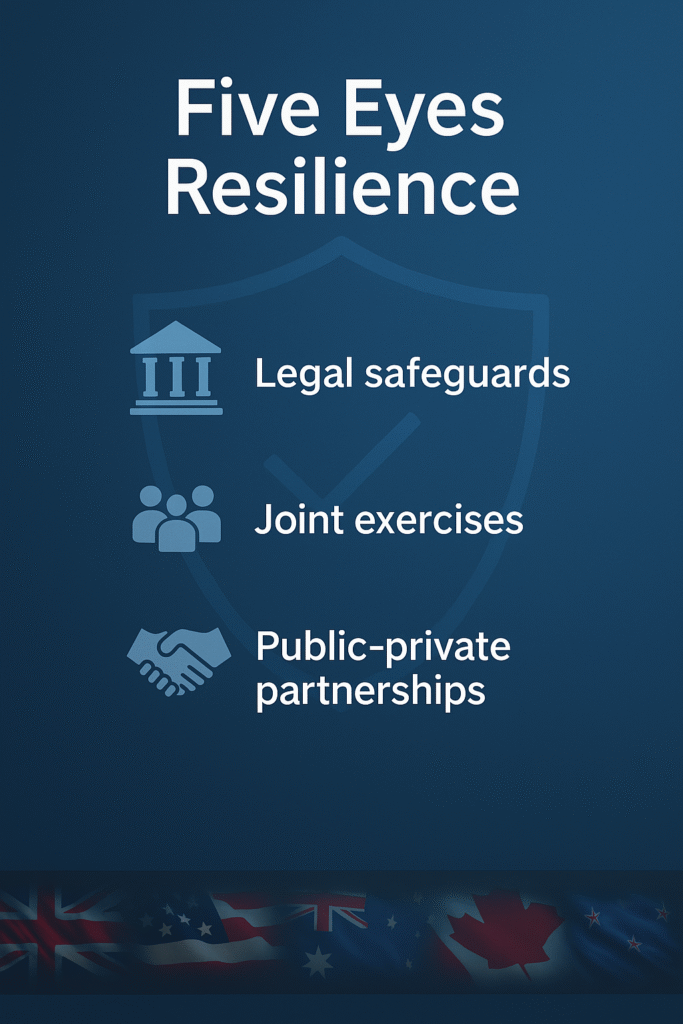
Formalizing Legal Safeguards for Intelligence Protocols
One powerful way to protect the Five Eyes alliance from future disruptions is to codify intelligence-sharing procedures into domestic law. Many analysts have argued that formal legislation would help protect the alliance from disruption during political transitions, reassuring partners that data pipelines will remain intact even when leadership changes or political agendas shift. Codifying these procedures would anchor the alliance’s foundations of trust and routine through unpredictable domestic politics and safeguard shared infrastructure from cyber-enabled threats.
Expanding Joint Cyber Training
Routine joint cyber exercises are vital for keeping the Five Eyes alliance resilient. As seen in NATO’s Cyber Coalition 2023 drills, these scenarios stress-test defensive systems, identify weaknesses, and strengthen confidence among international partners. These exercises also provide a way to standardize tools, processes, and information-sharing norms across complex multinational networks.
By expanding the frequency and scope of these exercises, the Five Eyes alliance can build familiarity that is not dependent on political personalities. When teams practice together regularly, they build relationships and workflows that can withstand turbulence from Trump foreign policy shifts or other sudden changes. This familiarity speeds up reaction times and helps maintain a unified allied cyber defense posture even under stress.
Strengthening Public-Private Partnerships
Public-private partnerships are another pillar of preserving the Five Eyes alliance. Many critical digital systems and advanced cybersecurity tools are owned or operated by private-sector companies. These firms provide threat intelligence, technical expertise, and security monitoring that national agencies cannot match alone. Governments should work closely with these partners, sharing indicators of compromise, forensic data, and actionable cyber threat intelligence to create a united front.
Strengthening these relationships through formal agreements, incentives, and routine data-sharing mechanisms is essential. For further reading on supply chain and private-sector resilience, you can explore Supply Chain Cybersecurity: 7 Critical Risks You Must Avoid, which discusses how similar cooperative models can defend against cascading failures.
With formalized protocols, deeper exercises, and robust public-private frameworks, the Five Eyes alliance can fortify its allied cyber defense against even the most politically disruptive events. Finally, it is worth considering what future scenarios might emerge and what policymakers should watch for as the next presidential cycle approaches
Conclusion and Future Scenarios
As global tensions continue to rise, the resilience of the Five Eyes alliance faces one of its most critical tests. Political instability and unpredictable Trump foreign policy shifts have shown how fragile even the most robust intelligence-sharing partnerships can be. If the United States again prioritizes unilateral moves over international cooperation, trust inside the Five Eyes framework could break down. That would have consequences far beyond classified documents, threatening the entire global structure of allied cyber defense and international intelligence sharing.
Experts have warned that dismantling trust networks within the intelligence community would roll back decades of cooperative security progress and open allies to sophisticated nation-state cyberattacks and hybrid operations. Cybersecurity cooperation cannot function without consistent, credible leadership. Allies depend on stable norms and values to keep their data flowing quickly and accurately during crises. A second Trump term that repeats previous patterns could undermine those pillars at the worst possible time.
If the Five Eyes alliance wants to survive, policymakers must act. Formalizing intelligence protocols in law, expanding joint exercises, and deepening public-private partnerships are actionable steps that can help protect the alliance. Investing in these measures would build durable trust, even when political winds shift. There is no time to wait. As the SolarWinds attack showed, adversaries do not hesitate to exploit weak seams in a fragmented system.
The global security order relies on shared resilience. Intelligence partnerships like the Five Eyes alliance anchor stability against complex hybrid threats, including ransomware, disinformation, and influence campaigns. If the next presidential term delivers more political volatility, the allies must stay committed to prioritizing cybersecurity cooperation. Their shared mission is bigger than any single leader or policy moment.
Hackers move fast. Governments often do not. Get weekly insights on AI-driven threats, deepfake scams, and global cyber shifts before they hit the headlines. Subscribe now to join 1,200+ readers decoding the new cyber battlefield with Quantum Cyber AI.
From here, the next challenge will be preparing for real-world stress tests as the global environment grows more hostile. This is not just a policy debate. It is an urgent question about whether Western democracies can defend themselves in an era of constant digital siege.
Key Takeaways
- The Five Eyes alliance is the world’s most powerful intelligence-sharing partnership, but its survival depends on trust and stable cooperation.
- Trump foreign policy moves during his first term strained relationships, including threats to cut off intelligence sharing with the UK over Huawei.
- Cybersecurity cooperation within Five Eyes is at risk from fragmented leadership and politicized intelligence, which can slow joint responses to attacks.
- Exercises like NATO’s Cyber Coalition and investments in Australia’s and the UK’s cybersecurity programs show allies are working to build resilience.
- Formal laws, public-private partnerships, and routine joint training are critical to maintaining the allied cyber defense framework through any political turbulence.
FAQ
Q1: What is the Five Eyes alliance?
The Five Eyes alliance is an intelligence-sharing partnership among the United States, United Kingdom, Canada, Australia, and New Zealand. It focuses on signals intelligence, counterterrorism, and allied cyber defense, forming one of the most comprehensive international security networks in the world.
Q2: Did Trump really threaten to withdraw intelligence sharing with the UK?
Yes. In 2020, President Trump warned the UK that U.S. intelligence cooperation could be reduced if Britain allowed Huawei to build parts of its 5G network.
Q3: Why is cybersecurity cooperation so critical to the Five Eyes?
The alliance’s cyber defense capabilities depend on fast, trusted information exchanges. If even one member’s network is compromised, adversaries can exploit shared data systems and harm everyone.
Q4: Can the Five Eyes alliance survive without U.S. leadership?
Other members like Australia and the UK have strengthened their national programs, but the alliance still relies heavily on U.S. resources and global reach. A cooperative and stable U.S. role remains essential.
Q5: How can the alliance be protected going forward?
Experts suggest codifying intelligence-sharing rules into law, expanding joint training, and growing public-private partnerships to safeguard resilience across changing political environments.
